|
the interview with Professor Masaaki Kimura continues
…
Morien Institute :
Carvings of symbols on one of those artifacts, a ‘line-engraved stone tablet’, are said to be similar to the artifact that has become known as ‘The Okinawan Rosetta stone’. Can you speak about the history of the ‘The Okinawan Rosetta stone’, and also of the ‘line-engraved stone tablet’?
Professor Masaaki Kimura :
“More than 10 sheets of tablets called ‘Okinawa Rosetta stones’ were discovered about 60 years ago at the western coast of Okinawa-jima (island). There exist similar symbols to the ‘+’ and the ‘v’ carved on the submarine tablet.”
Professor Masaaki Kimura holding one of the ‘artifacts’ recovered
from the sea-bed around the island of Yonaguni-jima
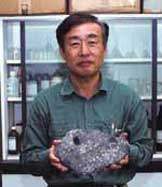
—
Okinawa, Japan
—
|
one of the ‘carved symbols’ found
on submarine rocks around the
seafloor near Iseki Point, Yonaguni
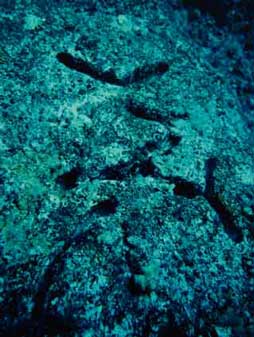
— Okinawa, Japan —
|
|
one of the tablets known as the
‘Okinawan Rosetta stones’
found on Okinawa 60 years ago
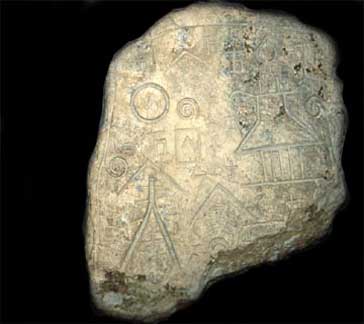
—
Okinawa, Japan
—
|
Morien Institute :
Are there any other artifacts with symbols or recognisable shapes carved on them that have been found underwater?
Professor Masaaki Kimura :
“We recovered a big cobble with relief of four-legged animal found underwater.”
Morien Institute :
Are there any symbols found carved directly into the rock, either on the Yonaguni structure itself or nearby?
Professor Masaaki Kimura :
“Some symbols are carved on the western part of Yonaguni (the westernmost island of Japan) Pyramid and on the upper surface of the Kusabi (wedge) rock. It is not certain if they are artifacts.”
|
the four-legged animal carved on
the ‘ox-rock’ looks similar in outline
to a water buffalo or an aurochs
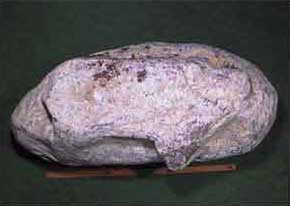
— Okinawa, Japan —
|
|
one of the many ‘wedge-rocks’ found
above and below water with definite
signs of ‘tool-marks’ made in antiquity
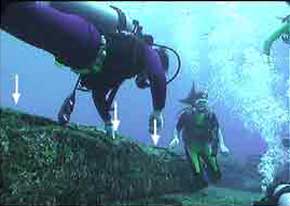
— Okinawa, Japan —
|
Morien Institute :
I have seen photographs of the ‘main’ and ‘upper’ terraces on the Yonaguni monument, and also of the ‘loop road’ that winds around the bottom. What aspects of these features convince you that ancient peoples once used them as such?
Professor Masaaki Kimura :
“There are holes estimated to be used for pillars and drains for water on the upper terrace.”
Morien Institute :
I gather that more evidence is coming to light about the methods used by ancient people to split the rock using wedges, and that this is true for samples both underwater off Iseki point and also on the island of Yonaguni itself. Can you give more details about this?
Professor Masaaki Kimura :
“There are many quarry marks on and off Yonaguni.”
|
the ‘Pu-Ru’ holes that were possibly
used as sockets for wooden pillars
before the ancient sea-level rose
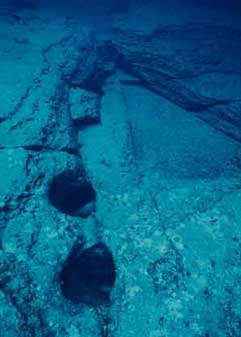
— Okinawa, Japan —
|
|
some of the ‘quarry marks’ found
on megaliths underwater near to the
No.1 Monument at Iseki Point
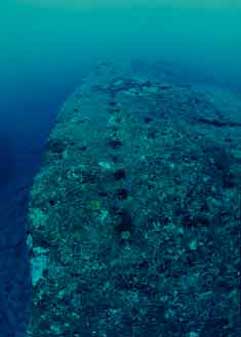
—
Okinawa, Japan
—
|
Morien Institute :
In February 1999 you presented a paper to The 11th Annual Symposium on Maritime Archaeology and History of Hawaii and the Pacific. Reading from the abstract, I was intrigued that you said, “The underwater structure off Yonaguni Island is called No. 1 monument or Iseki Point.” Does that mean there are other monuments, maybe a No. 2 or No 3 monument, and if so, what are their locations?
Professor Masaaki Kimura :
” No.2 – 5 monuments are surrounding the No.1 monument.”
|
|
Books About
Prehistoric Japan
“Ancient Jomon of Japan”
by
Junko Habu

Get This Book From:
Amazon.com
Amazon.co.uk
“Prehistoric Japan:
New Perspectives on Insular East Asia”
by
Keiji Imamura

Get This Book From:
Amazon.com
Amazon.co.uk
“In the Wake of Jomon: Stone Age Mariners and a Voyage Across
the Pacific”
by
Jon Turk
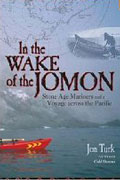
Get This Book From:
Amazon.com
Amazon.co.uk
“An Archaeological History of Japan, 30,000 B.P. to A.D. 700”
by
Koji Mizoguchi

Get This Book From:
Amazon.com
Amazon.co.uk
“Sacred Texts and Buried Treasure:
Issues on the Historical Archaeology of Ancient Japan”
by
William Wayne Farris

Get This Book From:
Amazon.com
Amazon.co.uk
“Shinto:
The Sacred Art of Ancient Japan”
by
Victor Harris
(Editor)
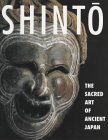
Get This Book From:
Amazon.com
Amazon.co.uk
“Jomon of Japan:
The World’s Oldest Pottery”
by
Douglas Moore Kenrick
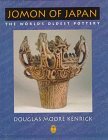
Get This Book From:
Amazon.com
Amazon.co.uk
if you would like to support
The Morien Institute
marine archaeology research
please send us a book

from our Wish List
|